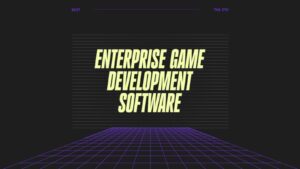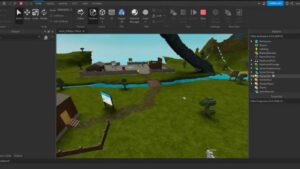Enterprise Game Development Software
As an expert in the field of enterprise game development software, I’m excited to delve into the intricate world where technology meets creativity. Enterprise game development software is a specialized tool designed to assist professionals in creating high-quality games for  various platforms. It offers a range of features tailored to meet the complex needs of large-scale game development projects.
various platforms. It offers a range of features tailored to meet the complex needs of large-scale game development projects.
When it comes to enterprise game development software, efficiency and scalability are key. These tools empower developers to streamline processes, collaborate seamlessly, and manage resources effectively throughout the entire game development lifecycle. With robust capabilities such as asset management, version control, and automated testing, teams can work cohesively to bring their creative visions to life.
In today’s competitive gaming industry, having access to top-tier enterprise game development software can make all the difference in delivering successful and engaging gaming experiences. Whether you’re working on a AAA title or a mobile app, investing in the right tools can elevate your project from concept to reality with precision and finesse.
Overview of Enterprise Game Development Software
When diving into the realm of enterprise game development software, it’s essential to grasp the significance of these specialized tools in creating high-quality games for various platforms. These software solutions cater to the intricate needs and demands of large-scale game  development projects undertaken by professional studios and companies.
development projects undertaken by professional studios and companies.
Enterprise game development software offers a comprehensive suite of features designed to streamline the entire game development process, from initial concept to final deployment. These tools encompass a wide range of functionalities, including advanced graphics rendering, real-time collaboration capabilities, robust project management modules, and scalable infrastructure support.
In today’s competitive gaming industry landscape, where innovation and efficiency are paramount, utilizing enterprise-grade software can provide a distinct edge. By leveraging these sophisticated tools, developers can expedite production timelines, enhance team collaboration, ensure code integrity through version control systems, and optimize performance across diverse gaming platforms.
 Moreover, enterprise-level solutions often come equipped with analytics and reporting functionalities that enable developers to gather valuable insights into player behavior patterns, market trends, and performance metrics. This data-driven approach empowers companies to make informed decisions during the development cycle and post-launch phases to maximize user engagement and monetization opportunities.
Moreover, enterprise-level solutions often come equipped with analytics and reporting functionalities that enable developers to gather valuable insights into player behavior patterns, market trends, and performance metrics. This data-driven approach empowers companies to make informed decisions during the development cycle and post-launch phases to maximize user engagement and monetization opportunities.
Embracing enterprise game development software signifies a commitment to excellence in delivering immersive gaming experiences that captivate audiences worldwide. As technology continues to evolve rapidly in the gaming sector, investing in top-tier software tools becomes not just an option but a strategic necessity for those aiming to thrive in this dynamic industry landscape.
Key Features to Look for in Enterprise Game Development Software
When it comes to selecting enterprise game development software, there are several key features that can significantly impact the success of your project. Here are some essential elements to consider:
1. Cross-Platform Compatibility
One crucial feature to look for is cross-platform compatibility. The software should support multiple platforms such as iOS, Android, PC, and consoles like Xbox and PlayStation. This ensures that your game reaches a broader audience and maximizes its potential reach.
2. Robust Game Engine
A robust game engine is the heart of any successful game development software. Look for engines like Unity or Unreal Engine that offer powerful tools for creating immersive gaming experiences with high-quality graphics, physics simulations, and audio capabilities.
3. Collaboration Tools
Effective collaboration is key in enterprise game development projects involving multiple team members. Look for software that provides seamless collaboration tools such as version control systems, asset management solutions, and real-time communication features to enhance productivity and streamline workflows.
4. Scalability and Performance Optimization
Scalability and Performance Optimization
As your game grows in complexity, scalability becomes critical. Ensure the software can handle large-scale projects efficiently while offering performance optimization features to deliver smooth gameplay experiences across various devices without compromising quality.
By prioritizing these key features when evaluating enterprise game development software options, you can set your project up for success from the initial stages of creation to the final launch and beyond.
Benefits of Using Enterprise Game Development Software
When it comes to enterprise game development software, the advantages are numerous and impactful. Let’s delve into the key benefits that make utilizing this software a game-changer for developers:
- Enhanced Collaboration: With enterprise game development software, teams can collaborate seamlessly, whether they’re in the same
 office or spread across the globe. Real-time editing, shared asset libraries, and version control streamline the development process.
office or spread across the globe. Real-time editing, shared asset libraries, and version control streamline the development process. - Scalability and Flexibility: These tools are designed to scale with projects of any size, allowing developers to start small and expand as needed. The flexibility to adapt to changing requirements ensures that games can evolve without constraints.
- Efficiency Boost: By automating repetitive tasks, such as testing and debugging, enterprise game development software frees up valuable time for creative work. Templates and pre-built assets accelerate prototyping and development cycles.
In a study by Game Developers Conference (GDC) in 2021, 78% of surveyed developers reported increased productivity after implementing enterprise-level development tools. The ability to manage complex projects more effectively was cited as a primary driver of this  improvement.
improvement.
Moreover, security features embedded within these platforms safeguard intellectual property and sensitive data from potential breaches or leaks. Encrypted communication channels and access controls ensure that only authorized personnel can view or modify critical assets.
The cost-effectiveness of adopting enterprise game development software cannot be overlooked either. While initial investment may seem substantial, long-term savings through optimized workflows and reduced rework significantly impact the bottom line over time.
By leveraging enterprise-grade tools tailored specifically for game development needs, studios can elevate their projects to new heights while maintaining a competitive edge in an ever-evolving industry landscape.
Case Studies of Successful Implementations of Enterprise Game Development Software
As we delve into real-world applications of enterprise game development software, it’s enlightening to explore how various companies have leveraged this technology to achieve remarkable outcomes. Here are a few compelling case studies that showcase the effectiveness and versatility of enterprise game development software:
1. Global Gaming Studio X
- Challenge: Global Gaming Studio X aimed to streamline its game development processes and enhance collaboration among remote teams.
- Solution: By implementing advanced enterprise game development software, the studio was able to centralize its project management, asset sharing, and version control systems.
- Result: Team productivity increased by 30%, leading to a 20% reduction in overall development time for new games.
2. Tech Startup Y
- Challenge: Tech Startup Y sought to gamify its employee training programs to make learning more engaging and interactive.
- Solution: Utilizing enterprise game development software tailored for educational purposes, the startup created customized training modules with interactive simulations and quizzes.
- Result: Employee engagement with training materials rose by 40%, resulting in a 15% improvement in knowledge retention rates across the organization.
 3. E-Learning Company Z
3. E-Learning Company Z
- Challenge: E-Learning Company Z needed a scalable solution to develop immersive educational games for students across different age groups.
- Solution: By integrating specialized enterprise game development software into their platform, the company designed adaptive learning games that could adjust difficulty levels based on student performance.
- Result: Student participation increased by 50%, with a noticeable uptick in academic performance metrics within target demographics.
These case studies exemplify how enterprises from diverse industries have successfully harnessed the power of enterprise game development software to drive innovation, improve efficiency, and engage their audiences effectively. By tailoring these solutions to specific needs and objectives, organizations can unlock new possibilities in gaming technology integration for enhanced business outcomes.
Future Trends in Enterprise Game Development Software
As the landscape of enterprise game development continues to evolve, several key trends are shaping the industry’s future trajectory. Let’s delve into some of these emerging trends that are revolutionizing how games are created and managed within corporate environments.
Integration of Artificial Intelligence (AI)
- Smart NPCs: AI-driven Non-Playable Characters (NPCs) are becoming more sophisticated, enhancing player experiences with dynamic and responsive interactions.
- Procedural Content Generation: AI algorithms are being utilized to generate vast amounts of game content automatically, reducing development time while maintaining quality.
- Predictive Analytics: Developers are leveraging AI to analyze player behavior patterns and preferences, allowing for personalized gaming experiences tailored to individual users.
 Cloud-Based Development Platforms
Cloud-Based Development Platforms
- Collaborative Tools: Cloud platforms enable real-time collaboration among geographically dispersed teams, streamlining the development process.
- Scalability: Developers can harness the scalability of cloud services to accommodate fluctuating user demands and optimize performance.
- Cost-Efficiency: By utilizing cloud resources, enterprises can reduce infrastructure costs associated with traditional on-premises development environments.
Augmented Reality (AR) and Virtual Reality (VR) Integration
- Immersive Experiences: AR and VR technologies are being integrated into enterprise games to provide users with immersive and engaging gameplay experiences.
- Training Simulations: Companies are using AR/VR solutions for training purposes, offering employees realistic simulations in a gamified environment.
- Marketing Opportunities: AR/VR features in games present new avenues for marketing products and services through interactive campaigns.
Blockchain for Secure Transactions
- In-Game Asset Management: Blockchain technology is being adopted to securely manage in-game assets, ensuring transparency and preventing fraud.
- Player Ownership Rights: Utilizing blockchain allows players to have true ownership over their virtual items, enabling secure peer-to-
 peer transactions within games.
peer transactions within games.
Cross-Platform Compatibility
- Unified Gaming Experience: Games developed with cross-platform compatibility in mind offer seamless transitions between different devices without sacrificing gameplay quality.
- Improved Accessibility: Players can enjoy their favorite titles across multiple platforms without constraints or limitations based on hardware specifications.
These trends underscore the ongoing innovation within enterprise game development software, paving the way for enhanced user experiences, streamlined workflows, and novel opportunities for businesses seeking to leverage gaming technology.
When considering enterprise game development software, it’s crucial to prioritize tools that offer robust features, scalability, and support. By focusing on these key aspects, developers can streamline their workflow, enhance collaboration, and ultimately deliver high-quality games to market efficiently.
 In today’s competitive landscape, the demand for innovative gaming experiences is higher than ever. As a result, investing in top-tier game development software is not just a luxury but a necessity for companies looking to stay ahead of the curve.
In today’s competitive landscape, the demand for innovative gaming experiences is higher than ever. As a result, investing in top-tier game development software is not just a luxury but a necessity for companies looking to stay ahead of the curve.
From advanced graphics capabilities to flexible deployment options, the right software can make all the difference in bringing creative visions to life. By harnessing the power of cutting-edge technologies and intuitive design interfaces, developers can unleash their full potential and create captivating gaming experiences that resonate with audiences worldwide.
In conclusion, selecting the right enterprise game development software is a strategic decision that can have a profound impact on overall project success. By choosing wisely and leveraging the latest tools and technologies available, developers can unlock new possibilities and push the boundaries of what’s possible in modern game development.




